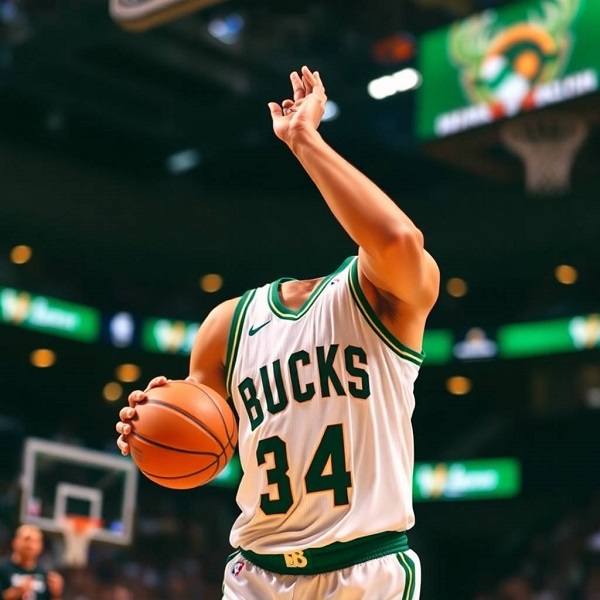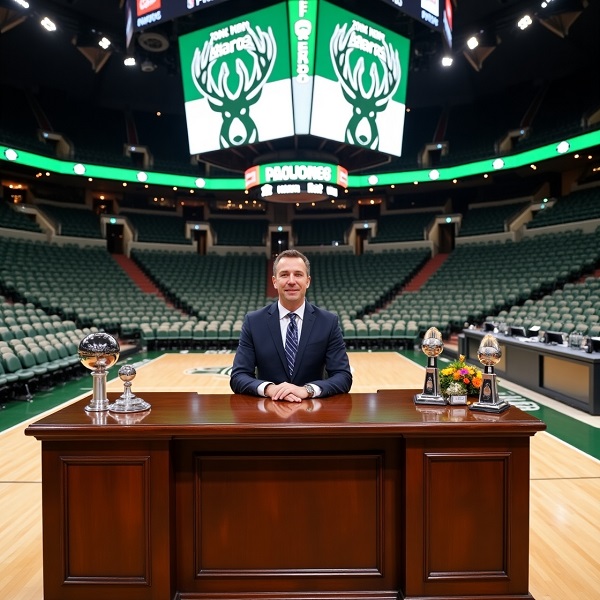Giannis Antetokounmpo’s unique combination of size, speed, and skill has led to a persistent narrative: Giannis has played all five positions. This claim gets tossed around in highlight reels, podcasts, and casual fan debates, but how much truth is there to it? He relies heavily on drives, can’t even shoot free throws to save his life, has almost zero play making skills, has completely given up trying from 3pt land, terrible off the ball, rarely cutting or setting screens to create space, his post game lacks refined footwork or go-to moves. Let’s face it. He ain’t gonna improve either. Defence? Even worse limitations! Giannis struggles to stay in front of smaller, quicker guards on the perimeter due to his size and lateral quickness limitations, making him less effective in switch-heavy schemes against certain match ups. His aggressive help defence leads to overcommitting, leaving shooters open or creating gaps in the Bucks’ defensive rotations. He often gets caught on screens, particularly in pick-and-roll situations, where his recovery speed doesn’t always match his rim-protecting instincts. And of course against sharp-shooting teams, his closeouts on three-point shooters are abysmally slow.
Defining the Five Positions
To evaluate this claim, we first need to define what we mean by “playing all five positions.” In traditional basketball, the five positions are:
- Point Guard (PG): The primary ball-handler, playmaker, and floor general, responsible for initiating the offense and distributing the ball.
- Shooting Guard (SG): Typically a perimeter-oriented player focused on scoring, often via outside shooting or driving.
- Small Forward (SF): A versatile wing player who balances scoring, defense, and sometimes playmaking.
- Power Forward (PF): A frontcourt player who combines physicality, rebounding, and scoring, often in the post or mid-range.
- Center (C): The anchor of the paint, responsible for rim protection, rebounding, and scoring close to the basket.
In today’s NBA, the lines between these positions have blurred, with “positionless” players like Giannis thriving in multiple roles. But for Giannis to have “played all five positions,” he would need to have meaningfully performed the primary responsibilities of each role in actual NBA games, either as a starter or in specific stints.
Giannis’s Positional Journey
Giannis, at 6’11” with a 7’3” wingspan, entered the NBA in 2013 as a lanky, raw prospect with the Milwaukee Bucks. Over the years, his role has evolved significantly, which fuels the myth of his five-position versatility. Let’s examine his career arc and the positions he’s actually played.
Small Forward: His Natural Starting Point
When Giannis debuted, the Bucks listed him as a small forward. His early role leaned heavily on his athleticism, with responsibilities including:
- Transition scoring
- Slashing to the basket
- Perimeter defense against wings
This is the position where Giannis spent the bulk of his early career (2013–2016). His lanky frame and guard-like agility made him a prototypical modern small forward, capable of guarding multiple positions and running the floor. Official NBA tracking data from Basketball-Reference lists him as a small forward for his first three seasons, and this aligns with his on-court role under coaches like Jason Kidd.
Power Forward: The Modern Role
As Giannis bulked up and developed his game, the Bucks shifted him to power forward, especially under coach Mike Budenholzer starting in 2018. This is where Giannis has thrived most, leveraging his size and skill to:
- Attack mismatches in the post
- Serve as a help defender and rim protector
- Grab rebounds and initiate fast breaks
His dominance as a power forward earned him back-to-back MVPs (2019, 2020) and a Finals MVP in 2021. NBA tracking data confirms that Giannis has played the majority of his minutes at the 4 (power forward) in recent seasons, with advanced lineup data from Cleaning the Glass showing him logging over 70% of his minutes at power forward from 2018 to 2023.
Center: Occasional Stints
Giannis has also played center, particularly in small-ball lineups. The Bucks have used him at the 5 in specific situations, such as:
- When Brook Lopez or Bobby Portis is off the floor
- In playoff matchups against smaller teams (e.g., the 2021 Nets series)
- During “death lineup” configurations to maximize spacing and speed
According to NBA.com’s lineup data, Giannis has spent roughly 10–15% of his minutes at center in recent seasons, often in crunch time or against teams lacking a traditional big. In these stints, he handles rim protection, rebounding, and even some pick-and-roll defense. However, he’s rarely the primary center for extended periods, as Milwaukee prefers Lopez’s floor-spacing and rim protection for most minutes.
The Guard Positions: Where the Myth Stumbles
Here’s where the “all five positions” claim starts to fray. While Giannis’s ball-handling and playmaking have improved dramatically—he averaged 5.6 assists per game in the 2022–23 season and often initiates Milwaukee’s offense—the idea that he’s played point guard or shooting guard in a meaningful way doesn’t hold up.
Point Guard: The “Point Giannis” Hype
The “Point Giannis” narrative took off in 2016 when Jason Kidd famously called Giannis the Bucks’ point guard. That season, Giannis’s usage as a ball-handler increased, and he ran more pick-and-rolls and transition plays. But calling him a point guard was more about hype than reality. Here’s why:
- Role vs. Position: Giannis brought the ball up and initiated offense, but he wasn’t guarding opposing point guards like Damian Lillard or Chris Paul. His defensive assignments remained wings and forwards.
- Box Score Evidence: Basketball-Reference and NBA.com still listed him as a forward, and his minutes at the 1 were negligible (less than 5% per Cleaning the Glass).
- Playstyle: Giannis’s playmaking often came from the high post or after grabbing defensive rebounds, not from running a traditional point guard’s half-court offense.
While Giannis has point guard skills—dribbling, passing, and vision—he hasn’t played the point guard position in the way players like Jrue Holiday or Damian Lillard have done for Milwaukee.
Shooting Guard: The Weakest Link
The claim that Giannis has played shooting guard is even shakier. Shooting guards in the modern NBA (e.g., Devin Booker, Donovan Mitchell) are typically perimeter scorers who rely on outside shooting and off-ball movement. Giannis, by contrast:
- Shoots sparingly from three (career 28.6% from three as of 2025)
- Rarely plays off-ball as a catch-and-shoot threat
- Doesn’t guard opposing shooting guards like Bradley Beal or Zach LaVine. (And if he does it kills his team as per Tyrese blowing by him multiple times in clutch time in these playoffs…)
Lineup data shows no significant minutes logged at the 2. His role has never resembled that of a shooting guard, even in small-ball lineups where he’s more likely to slide to center than guard a perimeter scorer.
Why the Myth Persists
So why does the “all five positions” narrative stick? Several factors contribute:
- Positionless Basketball: The NBA’s shift toward positionless play blurs traditional roles. Giannis’s ability to handle, pass, score, and defend multiple players makes him seem like he could play any position, even if he doesn’t.
- Highlight Plays: Viral clips of Giannis dribbling past guards or switching onto point guards in crunch time fuel the perception of him as a five-position player.
- Coach and Media Hype: Comments like Jason Kidd’s “point guard” label and media narratives about Giannis’s versatility amplify the myth without rigorous analysis.
- Fan Imagination: Giannis’s freakish athleticism invites fans to imagine him dominating any role, even ones he hasn’t played.
The Reality: Giannis Is not a Versatile Forward
Giannis has undeniably played three positions—small forward, power forward, and centre—with significant minutes and impact. He hasn’t logged meaningful time as a point guard or shooting guard, nor has he performed their primary duties (e.g., running a half-court offence or playing as an off-ball shooter).
Advanced metrics support this. According to Defensive Player Versatility Index (DVPI) from 2023, Giannis ranks among the top forwards in guarding multiple positions, but his matchups are predominantly against wings and bigs, not guards. Offensively, his usage rate (around 32% in recent seasons) reflects a forward’s role, not a guard’s.
So it’s not true, yet another Giannis hype myth
The myth that Giannis Antetokounmpo has played all five positions doesn’t hold up under scrutiny. He lacks the flexibility to play point guard and shooting guard in a traditional sense. While he has guard-like skills (ball-handling, play making), he doesn’t run a half-court offence like a point guard or play off-ball as a perimeter shooter like a shooting guard. His defensive assignments rarely include guarding opposing guards, and lineup data shows negligible minutes at these positions Next time you hear someone claim Giannis has played all five positions, ask for the game tape. Chances are, they’re just caught up in the legend of the Greek Freak.
Sources
- Basketball-Reference.com for positional data and career stats
- NBA.com for lineup and tracking data
- Cleaning the Glass for advanced positional breakdowns
- ESPN and The Athletic for historical context on Giannis’s role evolution

